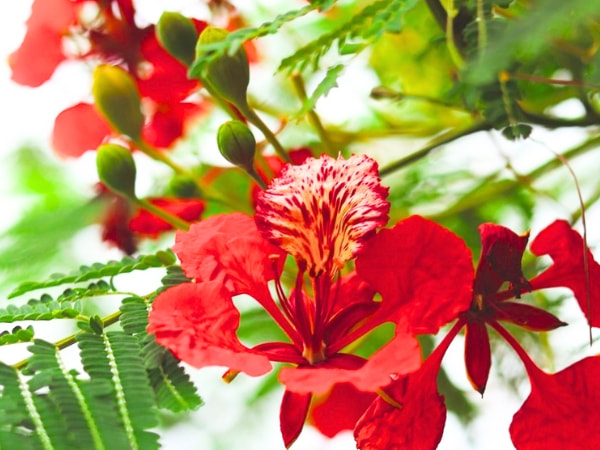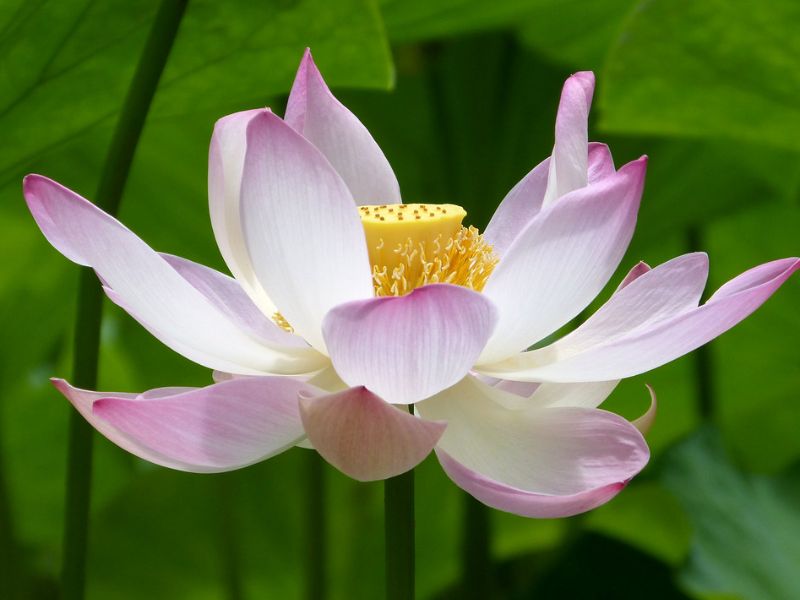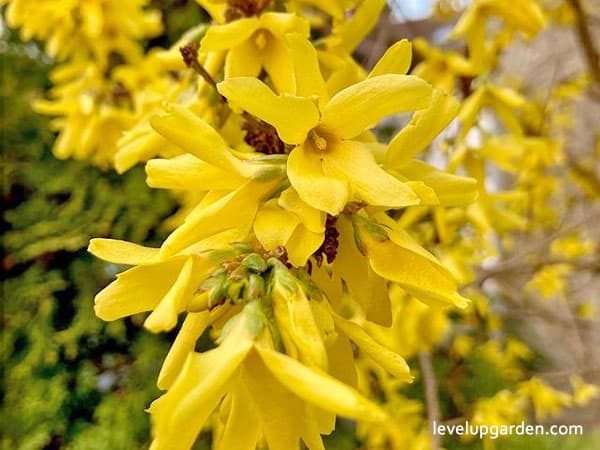Delonix regia, commonly called “flamboyant” or Royal Poinciana, is a species of flowering plant in the Caesalpinioideae subfamily of the Fabaceae family native to Madagascar. It is known for its fern-like leaves and spectacular orange flowers that bloom in summer, it is widely planted in tropical and subtropical regions of the world.
The Poinciana flower is so spectacular that no tree can be compared to it. This stately tree is a harbinger of summer, with its spectacular scarlet flowers covering the tree in a spectacular display. Delonix regia is a fast-growing, mimosa-like, two-leafed evergreen that makes an attractive garden element long after its long-lasting blooms have ended.
It is a fast-growing evergreen tree that produces a profusion of deep red flowers. Native to Africa, this tree is popular in many tropical and subtropical locations, but requires a large space away from buildings for its roots.

The leaves are twice pinnate compounds, with each leaf consisting of up to 25 pairs of lobes, which divide into up to 25 more pairs of lobes. The tree is world-renowned for the clusters of exquisite red flowers that cover the tree during the warm summer months. Each of the five petals is reddish orange or scarlet; one petal is larger than the others and has a yellow and white pattern; the flowers are white and yellowish in color. The fruit is a seed pod over a foot long.
I. Plant Profile – An Overview of the Royal Poinciana tree
| Common Name | Royal poinciana, flame tree, flamboyant, peacock flower, gold mohair, royal flame tree, Flame-of-the-forest, Semarak Api, Merak, Flamboyan, Fleur-de-paradis, Red Flame, Phoenix tree, Poinciana, Gulmohar |
| Botanical Name | Delonix regia |
| Family | Fabaceae |
| Plant Type | Tree |
| Soil Type | Loamy, sandy, clay, well-drained |
| Soil pH | Acidic, neutral, alkaline |
| Bloom Time | Summer |
| Flower Color | Red, orange |
| Hardiness Zones | 10–12 |
| Mature Height | 22-35 ft |
| Mature Width | 23-36 ft |
| Growth Rate | Fast |
| Exposure | Full Sun |
| Water Needs | Low, Average |
| Maintenance | Low |
| Soil Type | Clay, Loam, Sand |
| Soil pH | Acid, Alkaline, Neutral |

II. Appearance
Delonix regia (Flamboyant) is a tree with lacy, feathery green leaves that divide into numerous lobes and spread wide like an umbrella. It is evergreen except during the dry season and in areas with moderate winter cold, and is known for its spectacular flowers. From late spring to early summer, it produces bright scarlet-orange flowers with yellow and white spots, up to 10 cm across.
The flowers form into large clusters near the tips of the branches, and the flattened, mahogany-colored, bean-like seeds, which are 60 cm long, hang from the branches. When it’s mature, they break open and produce 20 to 40 seeds.The flowers are large, 8 cm long, with four scarlet or orange-red petals spreading out, the fifth petal, called the standard, is slightly larger and has yellow and white spots. They bloom in clusters along or at the ends of branches.
The leaves are pinnate compounds and pale bright green in color. The leaves are 30-50 cm long and are divided into 20-40 pairs of first lobes (pinnate lobes) and 10-20 pairs of second lobes (pinnate lobes).
III. Growing and Care Conditions
Plant a flame tree in a location where it has enough space to grow. Not only can this variety of tree reach up to 40 feet, but it can also spread up to between 40 and 70 feet wide. It can be damaging if not planted in the proper area.
Keep the plant away from walls, pavement, or anything else it might overtake. After planting, cover the soil around the tree to leave some space near the trunk, with a 2-inch layer of mulch.
Planting
Choose a well-drained, sunny location that receives 6 to 8 hours of sunlight per day. Next, dig a hole which is three times the width of the rootball and as deep as the rootball. Then, remove the plant from the container and place it upright in the hole so that the top of the rootball is flush with the ground.
At this point, backfill the hole and tread down lightly. Once the hole is completely filled, water the soil to let it settle and to eliminate air pockets. Finally, spread 3 to 5 inches of mulch around the plant to enrich the soil and help retain moisture and control weeds.
Light
This tree does well in sunlight, so choose a location that receives at least 6 hours per day. However, without sufficient light, you may not be able to see the spectacular red and orange flowers that characterize the himeshara.
Watering
We recommend watering Poinciana once or twice a week. If you are not sure when to water, check to see if the top 2 inches of soil are dry. If the soil is dry, it is time to water.
Fertilizer
Apply a slow-release fertilizer once a year in early spring, before new shoots emerge. Then, water the surrounding soil to allow the fertilizer to penetrate the roots. Follow the directions for use on the packaging.

Soil Requirements
Flame trees will grow in a variety of soil conditions as long as they are well drained. It can tolerate a wide range of clay, loamy, sandy, and gravelly soils. As long as the soil has a pH level ranging from 4.9 to 10.6, it will grow well.
Temperature
The Royal Poinciana Tree is native to tropical forests, which is why it grows well in warm, humid environments. It cannot tolerate temperatures below 45 degrees Fahrenheit. It can easily be grown outdoors in parts of Florida, Texas, and Hawaii. However, it is only suitable for reliably warm climates.
Pruning
Prune back any dead or diseased branches you find. Also note where branches rub against each other and prune them back as well. In early spring, before new shoots emerge, prune large branches that are low on the trunk or high on the trunk.
Pruning may also be done to shape the tree. Branches that are outside the silhouette should be cut off to achieve a fuller, wider silhouette, as they are more likely to break off in windy conditions. Aim to keep all major branches approximately 8 to 12 feet above the ground.
Pests and Diseases
Flame trees do not attract many insect pests, but a type of caterpillar may eat the foliage. However, they do not defoliate the entire tree. Additionally, spider mites can be a problem, especially if the tree is not in a humid environment.
Furthermore, if you find spider mites, increase humidity or take the plant outdoors. Silkworms can also be a problem. They appear under the leaves and can be removed with a cotton swab dipped in alcohol.
Root rot is a type of fungus that can rot the roots. To reduce root rotting, choose a well-drained soil that will reduce the chance of this fungus entering the soil. Another possible disease of Poinciana is stem canker disease, characterized by bark lesions and death. This fungal disease responds well to chemical fungicides.
Poinciana is not often plagued by pests and is a relatively low-maintenance tree. Spider mites and scale insects may be attracted to it, but a healthy flame tree can withstand an infestation. It may also attract termites and borers, but if you suspect an infestation, it is best to contact a professional arborist to take care of it.
IV. Uses
It grows quickly and is ideal for lawns, shade, and street trees. Royal Poinciana Tree is hardy in winter, it is an excellent flowering tree for gardens, parks, streetscapes, and large front yards. Mature trees make excellent shade trees.
It is suitable not only as an ornamental, but also as a shade tree in tropical regions. This is because, although usually modest in height mainly up to between 5 m and 12 m. It has a large spread and dense foliage that provide complete shade. In areas where the dry season is pronounced, it drops its leaves during drought, but in other areas it is nearly evergreen.
It has bright red flowers that make it perfect for parks, gardens, and along roadsides. Ideal as a shade tree and as a focal point for trees. It is salt tolerant and may be planted near the shore, but not directly on the beach.
The Poinciana tree tolerates poor growing conditions in urban landscapes, including soil compaction, pollution, drought, and poor drainage. The leaves are small and numerous, giving the plant a delicate, lacy texture. However, the plant does shed numerous twigs, leaves, and large woody pods.
In addition, the wood is used as fuel and has a calorific value of 4600 kcal/kg. Also, the flowers are used to feed bees. Royal Poinciana produces a water-soluble thick gum that is used in the manufacture of tablets and as a binding agent in the textile industry.

V. Why should you buy this plant
Each year, the Royal Poinciana heralds the arrival of spring with thousands of bright red flowers, a rich color that is rarely seen in other flowering varieties. The rich colors of the Royal Poinciana are not often seen in other flowering varieties, and it is also known as the “flame tree” because of its fiery coloration.
While most other varieties have pink or white flowers early in the season, Poinciana stands out for its flame-like hues. In fact, Poinciana trees are often the brightest trees in the neighborhood, attracting the attention of visitors and neighbors alike.
In addition, the lush, slender leaves of the poinciana, combined with its crimson flowers, give it a tropical feel. Since poinciana is semi-evergreen, its leaves do not fall off even in warm weather, providing rich green foliage in the garden throughout the year.
It is a fast-growing deciduous tree with a canopy of fiery red flowers that make it a neighborhood landmark. In late spring and early summer, large 6-inch flowers bloom on the tree. Not to be outdone by the flowers, the fern-like foliage provides a rich contrast to the fiery blooms.
Birders will love seeing the flowers and the brown seed pods, which are disliked by many buntings and hummingbirds. The botanical name is regia, meaning royal or magnificent, a fitting name for such an imposing tree.
Once planted, Poinciana requires little attention other than admiring its imposing appearance. Pruning is not necessary except to remove low branches. Poinciana is drought tolerant and only needs supplemental watering during dry periods.

It is also highly wind tolerant, but low branch pruning will help it withstand even more gusty winds. Pests and diseases are rarely a problem. Poinciana prefers full sun and will tolerate most soils except clay. It grows best in well-drained soil with a generous amount of organic compost. Fertilize three times a year with an organic flower and tree fertilizer (2-10-10).
Poinciana grows up to five feet a year, so you get exotic color and shade quickly. It also protects your home from the summer heat and insulates it in the winter, saving you money and energy in every season. In addition, this vigorous growth habit is extremely drought tolerant and grows well in dry, sandy soil where other flowering trees cannot tolerate the heat.
VI. FAQs
How long does a Royal Poinciana tree take to grow?
A newly planted Royal Poinciana tree will probably take 5 years to flower, although some trees have been reported to take 12 years or more. You can also purchase trees that have already flowered so you do not have to wait for them to flower.
How do I care for Royal Poinciana?
In the summer, give it plenty of water, but allow the soil to dry out between waterings. As a mature tree, it will be more tolerant of drought. Feed regularly with a balanced fertilizer during the warmer months and not at all in the winter.
How do I get Royal Poinciana to flower?
Plant in a well-drained, sunny location for ideal flowering. Poinciana’s showy flowers bloom from late spring to midsummer.
Can I grow Poinciana in bonsai?
Poinciana is a fast-growing, deciduous to evergreen tree, depending on the climate, with fern-like foliage and a natural umbrella-like form. It is an easy tree to use as a bonsai because it is tolerant of poor soil and strong pruning.
My poinciana is turning yellow?
As long as the leaves are old and inside, it is fine. If the new leaves are yellow and the veins are green, it means that the plant is iron and manganese deficient.







